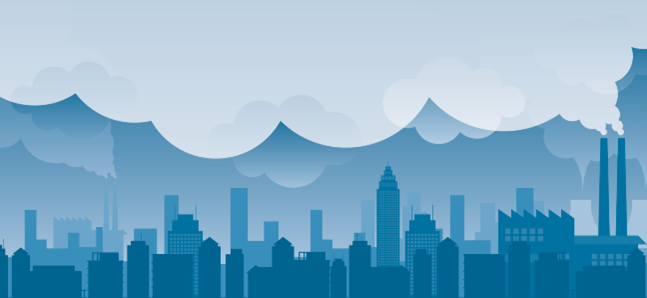Ambient air pollution accounts for an estimated 4.2 million deaths per year from stroke, heart disease, lung cancer and chronic respiratory disease. While pollution affects developed and developing countries alike, low- and middle-income countries experience the highest burden. In fact, around 91% of the world’s population lives in places where air quality levels exceed World Health Organization limits.

What is Air Pollution?
Particulate matter (PM) is a mixture of extremely small particles and liquid droplets that can be found in smoke and haze. The main sources of man-made Particulate matter are the combustion of fuels (by vehicles, industry and domestic properties) and other physical processes, such as tyre/tire and brake wear. Natural sources include wind-blown soil and dust, sea spray particles, and fires involving burning vegetation.
particulate matter is often classified according by aerodynamic size and referred to as:
- Coarse particles (PM10), which are less than 10 microns (µm) in diameter.
- Fine particles (PM5), which are less than 2.5 µm in diameter.
- Ultrafine particles (PM1), which are less than 0.1 µm in diameter.
Fine particles (PM2.5) are a public health concern, because after they are breathed in, they generally pass through the throat and nose and enter the lungs, from which point they can cause serious health effects on the rest of the body, particularly among the frail elderly or people with clinically significant heart and blood vessel disease. Breathing in fine particles can change the way the heart and blood vessel’s function and blood clots, leading to heart attacks, stroke, life-threatening heart rhythm disturbances, and/or heart failure.
An extensive body of evidence also ties long-term exposure to particulate matter to respiratory disease. Outdoor air pollution, specifically, particulate matter, has been classified by the International Agency for Research on Cancer (IARC) as carcinogenic to humans (a Group 1 carcinogen) and causing lung cancer.
Particles aren’t the only source of air pollution. Others include nitrogen dioxide (NO2), sulphur dioxide (SO2), ammonia (NH3), ozone (O3), and non-methane volatile organic compounds (NMVOCs).
Nitrogen dioxide (No2) is a gas produced along with nitric oxide (NO) by combustion processes, such as those created by diesel light-duty vehicles. Other sources include power generation, industrial processes, and domestic heating.
Sulphur dioxide is produced when sulphur-containing fuels, such as coal, are burned. It has an irritant effect on the lining of the nose, throat and airways. Chemical reactions of sulphur oxide can also produce sulphates, which remain in the air as secondary particles, contributing to the particulate matter mix.
Ammonia is a gas released into the atmosphere from natural and man-made sources. Once emitted into the atmosphere, it can cause nitrogen enrichment (or eutrophication, which can lead to death of animal life from lack of oxygen in bodies of water) and acidification of soil and water. Atmospheric ammonia also reacts with acid gases, such as sulphuric and nitric acid, to form secondary PM2.5.
Ozone is a gas which occurs both in the earth’s upper atmosphere and at ground level. The effects of exposure are predominantly respiratory, but adverse effects on the cardiovascular system have also been reported.
Non-methane volatile organic compounds, or NMVOCs, consist of a large variety of chemically different compounds, both natural and man-made. Total emissions in the UK decreased by 68% between 1970 and 2016, largely reflecting the decline in coal mining.
Indoor Air Pollution
Air pollution isn’t encountered only outdoors. A number of sources of indoor air pollutants can harm health, including:
- Carbon monoxide, nitrogen dioxide and particulates from domestic appliances (boilers, heaters, fires, stoves and ovens), which burn carbon-containing fuels (coal, coke, gas, kerosene and wood).
- Volatile organic compounds from cleaning and personal care products, building materials and household consumer products (e.g., paints, carpets, laminate furniture, cleaning products, air fresheners, polishing).
- Tobacco smoke.
- Radon, a naturally occurring radioactive gas that comes from the ground as the earth decays. There is an increased risk of lung cancer if exposed to high levels of radon for a long time.
``
Economic Inequality
Evidence shows that people in low-income areas are most adversely affected by air pollution, as they are more likely to:
- Have existing medical conditions.
- Live in areas with poorer outdoor and indoor environments (for example, near industry or busy roads).
- Have less access to jobs, healthy food, decent housing and green spaces.
In the United States, two Chicago residents -- Cheryl Johnson and Peggy Salazar -- lead two of the city’s oldest environmental advocacy groups, demanding that the city and industry leaders undo—and stop perpetuating—decades of unfair policies that have left communities of color and low-income residents overburdened with toxic air pollution and other environmental health hazards. Both women grew up on Chicago’s South Side, in some of the city’s most polluted neighborhoods, in the shadow of dirty industries, including steel mills, coal plants, manufacturing plants, and storage facilities.
What Can Be Done?
The U.S. Environmental Protection Agency is studying how climate change and air quality interact and the consequences for public health and the environment. EPA scientists have already provided evidence that future temperature increases will increase air pollution levels in some regions of the country. Urban areas already suffering from pollution problems may incur the greatest burden of these changes.
Meanwhile, local authorities can implement measures to reduce air pollution caused by road traffic and other sources; and design healthy environments, bringing in spatial planning, urban design, road and building layouts, and green spaces.
Health professionals and local government can also play a part by helping the public understand the health effects of air pollution, as well as actions they can take to reduce their day-to-day and lifetime exposure to air pollution.
SEKISUI Diagnostics
Our realization that a better future starts with our actions today prompts us to remain focused on the principles of our parent company, SEKISUI Chemical Co., Ltd. Future sustainability begins with environmental leadership. We strive to deliver products that have minimal impact on the environment while working as a team to conserve, recycle and improve our own surroundings. We understand that its not just the impact on the environment, but also how it impacts the health of populations.



Share Article